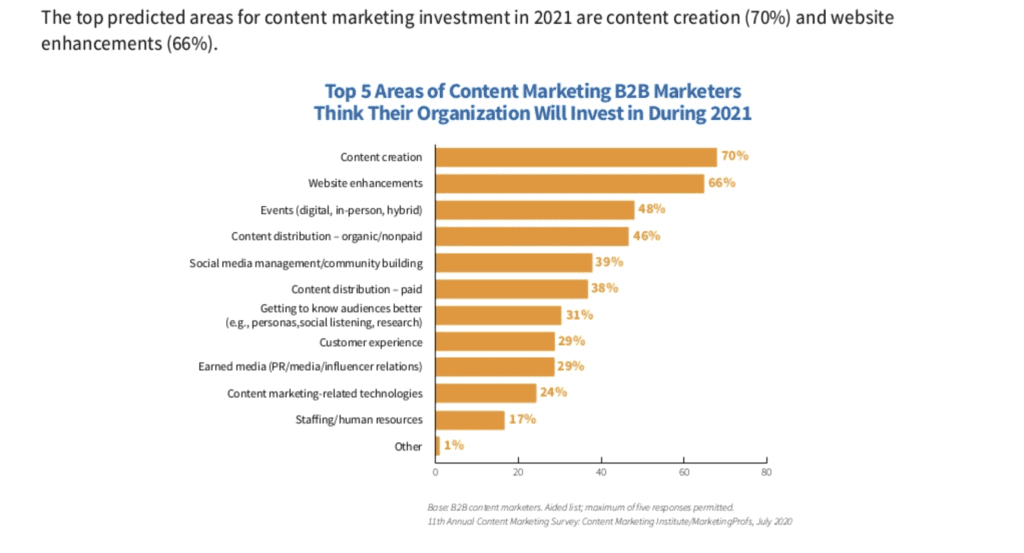In looking to the year ahead, we wanted to compile some of the ideas driving the content marketing world – identifying the bigger ideas in order to consider how they could help to direct our own work, both this year, and into the future.
After reading, watching, and listening to a wide range of industry purveyors of the content future, what we took away was surprisingly cohesive, and could be sorted into a few major themes:
- Understanding where the blog fits into the modern content ecosystem,
- Shifting to increasingly targeted distribution and promotion strategies,
- Customer education as a critical differentiator – with video as the aspirational medium of delivery,
- Delivering authenticity as executed through story-doing, not story-telling,
- A new standard for social consciousness, with transparency coming first.
As we were laying out our internal content strategy, we aimed to identify one key takeaway corresponding to each item, with the intention of holding ourselves to acting on them.
Here’s how it all works together:
Where Does the Blog Fit In Nowadays?
We were wondering about the state of the blog – it’s not uncommon to see folks condemning it as an obsolete and ineffective channel (the irony being that this message is most often delivered in blog format). It’s true that a large quantity of blog content out there is superfluous “content mill” fodder that disproportionately prioritizes a range of factors above providing client value.
Smart marketers see the blog as an opportunity to create content that is valuable and visible – through methods like digging deep into pointed topics and questions from the bottom of the funnel. Yes, it used to be easier to cast a wider net – today’s blog is more like spearfishing. Starting at the narrower part of the funnel, where the lines between lead generation and customer experience are more blurred.
In any case, if your blog is translating into conversions or other markers of success that you have set for yourself, you are doing something right.
Key Takeaway: We will continue to build on the three buckets of content on this blog – each with different KPIs:
- High-traffic posts with low conversion rates (For example: Best Free Stock Photo and Video Websites)
- Low-traffic posts with high conversion rates (For example: How ReviewStudio Simplifies Online PDF Collaboration and Markup)
- Engagement-driven content, measured by time on page and how often we refer to it in customer emails (For example: 4 Power User Features and Tips You May Have Missed in ReviewStudio)
Distribution as a Missing Puzzle Piece
One area that came up repeatedly in industry experts’ outlooks for the year ahead is distribution. The majority of businesses and companies would benefit from being more intentional in their distribution strategies. In a Content Marketing Institute survey, only 46% of B2B content marketers identified content distribution as a major area of investment for 2021, as compared to 70% prioritizing content creation.
 Some experts suggest focusing on doing one to three channels really well rather than trying (and failing) at being truly multichannel. Other paths are laser-targeting groups through community management or exploring underutilized channels (Quora and Reddit can have high value for some brands but are often dismissed). When leaning into the customer education piece described in the following section, platforms dedicated to education and knowledge-sharing tend to have very useful metadata and categorization options to help connect with very specific audiences. And some, like Skillshare and even YouTube, have no-to-low barriers to entry, with no real approval processes.
Some experts suggest focusing on doing one to three channels really well rather than trying (and failing) at being truly multichannel. Other paths are laser-targeting groups through community management or exploring underutilized channels (Quora and Reddit can have high value for some brands but are often dismissed). When leaning into the customer education piece described in the following section, platforms dedicated to education and knowledge-sharing tend to have very useful metadata and categorization options to help connect with very specific audiences. And some, like Skillshare and even YouTube, have no-to-low barriers to entry, with no real approval processes.
Key Takeaway: The Bullseye Framework is one we continue to use to identify our key channels of focus while we are always experimenting with new ideas. It’s important because it provides a structured approach to channel adoption.
Educational Video as a Powerful Tool
For much of the last half-decade, content marketers have been pressed to act on an urgent but vague insistence that video is king. Over the past year, we’ve seen platforms like Masterclass, Skillshare, and Zoom digital events grow into household names as people everywhere turned to hobbies, personal growth, and skill development in order to “get something” from an otherwise passive time.
This trend is partially because video is easier than ever to produce and consume, but it’s also a great tool for visual communication – and learning. Over the past year, many people were forced into an unfamiliar professional territory and found themselves re-skilling for a new job or needing to get up to speed on a new way of operating in a relatively condensed timeframe.
As brands, we can be educators. We have inside knowledge on what we are selling and can help people navigate new territory with our expertise. Video will continue to be a great opportunity to invest in customer education, whether it’s through live webinars, video tutorials, or multi-part series and courses hosted on other platforms. Taking on these kinds of projects can be intimidating, but often existing content can be “recycled” and expanded – social media posts compiled into a list of “quick tips” or a blog post as a jumping-off point for a panel discussion. A panel discussion or webinar can then be re-packaged into “bite-sized” video content.
Key Takeaway: We are always looking to create video and other content to improve our customers’ (and their customers’) experiences. Our key takeaway is that while it can deliver results, there’s a high opportunity cost to creating video, especially if it’s not a core competency.
Story-Doing and Actively Contributing Tangible Value
In 2021, content needs to be focused on story-doing. To put it metaphorically, the brand story should function as a verb, rather than as an adjective. Those who are already doing this well understand that the difference between the passive and being deeply involved and invested – story-telling vs. story-doing – is in contributing something tangible, valuable, and specific. Authentic content will take this to heart in 2021, moving more businesses to engage with their mission and mandate in meaningful (and material) ways.
Key Takeaway: One important piece has been to augment our content vision to produce more content about our experiences, involving our audience whenever possible, and always asking “what will our reader/customer take away with them?”
No Social Consciousness Without Transparency
In 2021 and beyond, brands will find it increasingly difficult to position themselves in the broader commercial ecosystem without a fully-integrated social responsibility plan built into their mandate and informing their content strategy. Some posit that consumer digital behavior fast-forwarded about five years in a matter of weeks in 2020 – well, consumer trust and media literacy evolved alongside it.
After a trying year that for many called into question frameworks previously taken at face value, consumers are more skeptical than ever of institutions – especially given the current no-holds-barred nature of the attention economy. It will be very difficult to engage in any meaningful social responsibility without also committing to transparency at all levels – including content output.
Key Takeaway: Any efforts we make to use social responsibility within (content) marketing, need to be rooted in our culture, and align with a triple-bottom-line mandate.
How do These Ideas Align with Yours?
Do these themes align with your content marketing plans for the upcoming months and beyond? And what strategies or tools are you employing this year as you work toward your broader marketing goals?
Ultimately, it seems the number of “must-have” distribution channels is increasing, with a few new areas that marketers must be aware of emerging each year. TikTok was one recent example. Clubhouse is growing quickly. Is there still opportunity in podcasting?
Being aware is key. It’s possible that internal alignment makes you perfectly suited to jumping on the next great trend. That said, better to be the master of your domain, than chase shiny objects.






